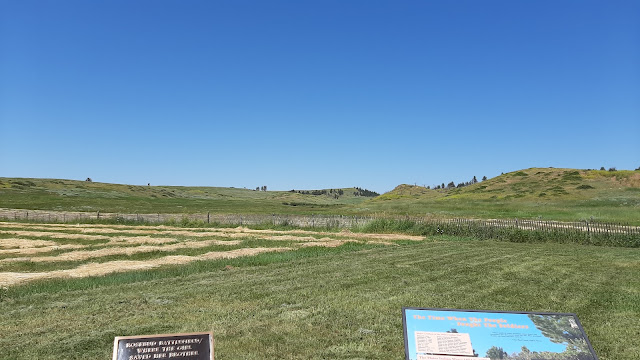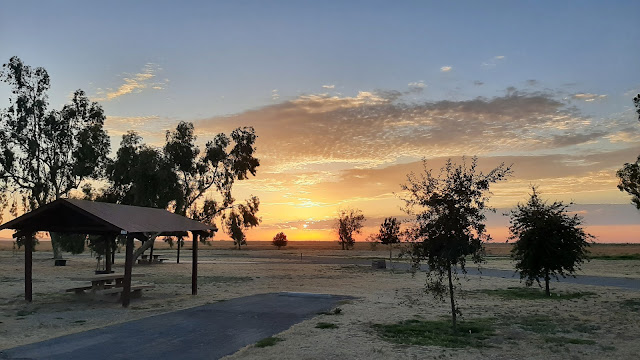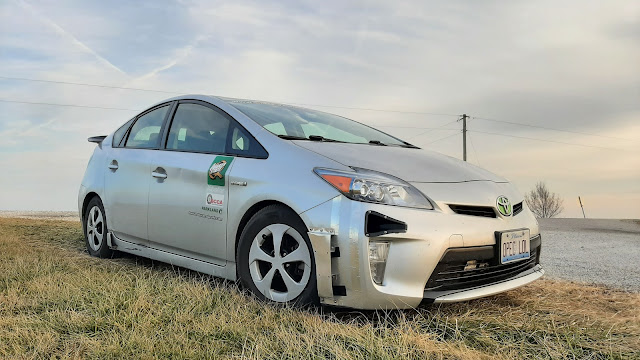This summer road trip season may be my last for a few
years, since I will be enrolled in school again full-time starting Monday and plan to take summer classes next year.
Knowing this, I decided to go on my longest trip ever: starting from my home in
Illinois, I drove to Phoenix and stayed with family, then over to Pasadena, up
the Central Valley to San Francisco, through the Redwood Parks to Tacoma (my
hometown), then across Washington and Idaho to Bozeman where I have more
family, and finally to the Black Hills of South Dakota and then home—more than
6,000 miles in all.
 |
Top: Sunset at Colonel Allensworth State Park, California.
Above: The Coastal Redwood is absolutely incredible; these trees in northern California, the Giant Sequoia to the south, and the Dawn Redwood in China are the last remnants of the Cretaceous forest that once covered most of the globe, according to the placards at Humboldt Redwoods State Park. |
Since I’m paying tuition now and need to be frugal, road
tripping efficiently was one of my primary goals. Here’s how I ensured I spent
as little as possible on gas.
Before You Go
Driving efficiently begins long before you pack up your
car and head out on the road. For me, my first choice was which car to drive: I
can choose from my 1991 Toyota pickup or 2013 Prius. The route I planned would
take me down Forest Service roads and unknown terrain in multiple state parks
and national forests, so this required some thought. Should I take the truck, which was designed for off-road use, or the Prius, which was not and is also lowered nearly an inch and a half? Ultimately, I opted for
the Prius since most of my driving would be on interstate highways, the Prius
is more than twice as efficient as the truck, and the Prius has air conditioning while
the truck does not.
 |
| Manzano Mountains State Park, outside Albuquerque. The continued fitment of this tent was one of the stipulations of my spoiler project. |
Regardless of your vehicle choice, before you go you can
(and should!) test aerodynamic modifications to lower drag, reduce lift, and/or
improve stability. The pernicious myth that, because manufacturers have wind
tunnels and supercomputers, there is nothing you can do to improve the
aerodynamics of your car is just that—a myth. Production cars, SUVs, and trucks
are optimized to meet a variety of program goals and design objectives; when
you modify an existing car yourself, you are subject only to your own criteria. For example, Toyota cannot sell a car in the US
without an external driver’s mirror; according to the laws of the state where
my two Toyotas are registered, I am free to remove them to reduce aerodynamic
drag—and have, as one part of an aerodynamic modification scheme
for each vehicle.
Your modification plan can also include reducing the mass
of your vehicle. As cars and SUVs get heavier, this becomes more important—but
also harder as more systems and components are integrated and comforts
we used to do without become increasingly compulsory.
 |
| I removed the sound system in my Prius in 2018. Most people think I'm crazy for doing that; however, I think you all are nuts for living with the distraction of recorded noise every waking moment as if being alone with your thoughts is an unconscionable punishment. (I'm joking. Kind of). |
Finally, you should make sure whichever vehicle you
choose to drive—electric or ICE—is up to date on its maintenance, has no major
issues or required services coming up, is properly aligned, has good tires,
etc. Keeping up on maintenance reduces the chance that something drastic will
happen on the road, and good low-rolling-resistance tires and a good alignment will improve efficiency.
For this trip, I rotated the tires and checked brakes,
fluids, and filters a little earlier than Toyota specifies since I would hit
140,000 miles just as I got home—when I would rotate the tires again, check
brakes and fluids, and do an oil change. Timing is everything. I also made sure
to test things such as radiator flow in the weeks
leading up to the trip, to reduce the possibility of a cooling-related issue.
Packing and Preparation
For best efficiency, pack light. Don’t bring a bunch of
stuff with you if you don’t really need it and probably aren’t going to use it.
There are two reasons I suggest the above: first, additional
mass reduces energy efficiency; second, the more
you pack, the harder it will be to fit it all inside your car.
Why is that important? Anything that has to be packed,
carried, or stowed outside your car will disrupt its shape and, consequently,
its aerodynamics. The impact of a rooftop box or, worse yet, a soft bag on
aerodynamic drag and lift can be massive. I lost count of how many rooftop
tents I saw on other cars over the course of this trip, on everything from
minivans to pickup trucks. Ditto rooftop boxes, soft-sided bags, kayaks, canoes, bikes, and empty roof racks. If you can fit it inside your car, put it inside. Failing that, if
you can carry it behind your car, on a hitch-mounted rack, put it there.
Use the roof as an option of last resort (and remove the roof rack if you aren't using it).
 |
| My Prius, fully packed and ready to leave Bozeman. Notice that it looks exactly the same as if it weren't carrying anything. |
On the Road
Finally, the way you drive can have a significant impact
on the efficiency of your car.
First and foremost, if you want to reduce the energy
required to get from one place to another, especially over long distances of
highway travel, slow down. Don’t be a rolling
roadblock, but don’t blast around like you’re on a certain European ring road
either. As a side benefit, keeping closer to the speed limit means you don’t
need to worry as much about being pulled over.
I stayed at or near the posted limit, except for a few
times coming down mountain passes where I let the car cross 80 mph. Whatever
speed you settle on, be smooth, consistent, and predictable (this includes
using turn signals, Californians).
Get in the habit of daily maintenance checks, especially
if you’re driving multiple days in a row at a time. Keep an eye out for
bellwethers: a tire that’s gone low overnight, engine coolant level not where
it should be, one wheel covered in brake dust while the others are clean, etc. Catching
problems or potential problems early can save headaches later.
Along with driving predictably, make sure you constantly
watch your mirrors and the drivers around you. Try to anticipate what other
drivers will do; watch the car—especially the front wheels and which direction
they are turning—and the driver’s eyes (if you can see them) to predict where
someone else is headed. Be diligent about checking your mirrors; if someone
behind you is driving erratically, often it is better to slow down and let them
go ahead of you where you can control your reaction to their car rather than
vice versa. If you are in heavy traffic and trying to keep up with anticipating
other drivers’ behavior, turn off your radio—it’s a distraction that negatively
impacts your attention to the task of driving (not so crazy now, am I?).
Home Again, Home Again, Jig-a-jig-jig
With a little forethought and planning, you can ensure
that your next road trip is efficient, safe, and enjoyable. Keep meticulous
track of your mileage and fuel purchases for assessment when you get home:
 |
| Out of all the gas station/truck stop coffee on this trip, the only brand I cannot recommend is Quik Trip—easily the worst coffee on the interstate. |
I finished this trip at more than 52 mpg and $451.79 in fuel cost—not bad for a
10-year-old hybrid with nearly 140,000 miles on its odometer, and significantly less than the cost of plane tickets. The trip overall
was a success, with no mechanical failures and only one minor electronic
problem (a Tire Pressure Monitoring System sensor that crapped out in
California). I got to see four out of my 7 siblings, visit the Crazy Horse
Memorial again, watch wild horses on the Salt River outside Phoenix, camp in
the Black Hills, and play a recital on the exquisite Brombaugh organ at Christ
Episcopal Church in Tacoma:
 |
| This also happens to be the instrument I took lessons on in high school, and I won a playing competition here in college. |
 |
| Crazy Horse Memorial, Custer, SD. Started in 1948, it's supposed to look like the plaster statue when finished. |
 |
| Black Fox campground, Black Hills National Forest. This campground is only accessible by driving down at least 15 miles of dirt and gravel road. It's always fun rolling up in a lowered Prius to a site full of lifted Jeeps and pickup trucks. |
I visited the Rosebud and Little Bighorn battlefields in
Montana, a Native American buffalo jump, the Golden Gate bridge, JPL, and the
famous I-5 Portland rest area:
 |
| Rosebud battlefield. Lakota warriors led by Crazy Horse came through this draw on the morning of June 17, 1876, surprising US soldiers under the command of Gen. Crook. Crook withdrew to Wyoming rather than continue northward as he was supposed to. Eight days later, Custer was killed 30 miles to the northwest. |
 |
| The Golden Gate Bridge in its natural guise. |
My last piece of advice is this: you never know when
you’ll get the chance again, so go for it now.
 |
| A mail-order plane at the Museum of the Rockies. Two brothers put this together from a kit in the early 1930s. |
















Comments
Post a Comment